
Kid Icarus is a platform video game developed and published by Nintendo for the Family Computer Disk System in Japan and the Nintendo Entertainment System in Europe and North America. It was released in Japan in December 1986, in Europe in February 1987, and in North America in July.

Mario Tennis is a 2000 sports video game developed by Camelot Software Planning and published by Nintendo for the Nintendo 64. Following Mario's Tennis, it is the second game in the Mario Tennis series. The game is known for being the introduction of Luigi's arch-rival, Waluigi, and the re-introduction of Princess Daisy and Birdo.

Sonic the Hedgehog is a 1991 platform game developed by Sonic Team and published by Sega for the Genesis/Mega Drive. It was released in North America on June 23 and in PAL regions and Japan the following month. Players control Sonic the Hedgehog, who can run at near supersonic speeds; Sonic sets out on a quest to defeat Dr. Robotnik, a scientist who has imprisoned animals in robots and seeks the powerful Chaos Emeralds. The gameplay involves collecting rings as a form of health, and a simple control scheme, with jumping and attacking controlled by a single button.
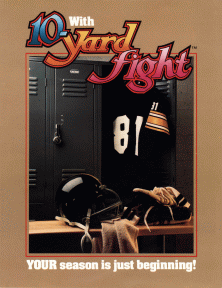
10-Yard Fight is an American football sports video game that was developed and published in Japan by Irem for arcades in 1983. It was published overseas by Taito in the Americas, by Electrocoin in Europe, and by ADP Automaten GmbH in West Germany.
A sports video game is a video game that simulates the practice of sports. Most sports have been recreated with video games, including team sports, track and field, extreme sports, and combat sports. Some games emphasize playing the sport, whilst others emphasize strategy and sport management. Some, such as Need for Speed, Arch Rivals and Punch-Out!!, satirize the sport for comic effect. This genre has been popular throughout the history of video games and is competitive, just like real-world sports. A number of game series feature the names and characteristics of real teams and players, and are updated annually to reflect real-world changes. The sports genre is one of the oldest genres in gaming history.
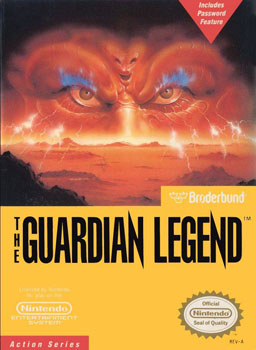
The Guardian Legend is a 1988 hybrid action-adventure/shoot 'em up video game developed by Compile for the Nintendo Entertainment System (NES). It is the sequel to the 1986 MSX game Guardic, and was published and released in Japan by Irem in 1988, in North America by Broderbund in 1989, and in Europe by Nintendo in 1990.

Soccer is a sports video game developed by Intelligent Systems and published by Nintendo for the Nintendo Entertainment System. It was released in Japan and North America in 1985, and in Europe in 1987. It was released for the Famicom Disk System in 1986. It was released on the Wii and Wii U Virtual Console on June 12, 2014. It was released on Nintendo Switch Online in 2018.

Kirby's Dream Course is a 1994 miniature golf video game developed by HAL Laboratory and Nintendo EAD and published by Nintendo for the Super Nintendo Entertainment System (SNES). A spin-off of the Kirby series and the first released for the SNES, players control the pink spherical character Kirby through a series of courses by launching him towards the goal hole at the end. Kirby can hit enemies to collect power-ups that grant him unique abilities, such as those that allow him to destroy certain obstacles or fly around the level.
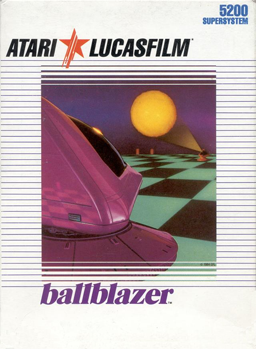
Ballblazer is a futuristic sports game created by Lucasfilm Games and published in 1985 by Epyx. Along with Rescue on Fractalus!, it was one of the initial pair of releases from Lucasfilm Games, Ballblazer was developed and first published for the Atari 8-bit family. The principal creator and programmer was David Levine. The game was called Ballblaster during development; some pirated versions bear this name.
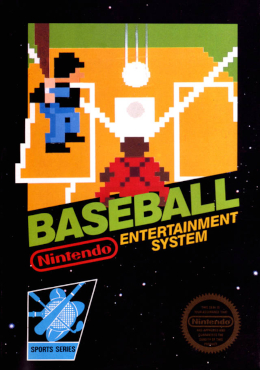
Baseball is a video game from Nintendo. It was released December 7, 1983, after the July 15 launch of the Famicom in Japan. In 1984, it was ported to the VS. System arcade as VS. Baseball with additional graphics and speech, becoming a number one hit in Japan and North America that year. It was localized as a Nintendo Entertainment System launch game in North America in 1985, and in Europe in 1986. IGN said the universal appeal of the American sport made Baseball a key to the NES's successful test market introduction, and an important piece of Nintendo history. The game was also competing with Sega's arcade hit Champion Baseball, released earlier in 1983.

Double Dribble is an arcade basketball video game developed and released by Konami in 1986. It was the second basketball arcade video game by Konami, following Super Basketball. It was considered the most realistic basketball sports video game upon release, with fast-paced action, detailed players, a large side-scrolling court, innovative cinematic slam dunks, and detailed sound effects, beginning a trend where presentation would play an increasingly important role in sports games.

Kirby’s Block Ball, known in Japan as Kirby no Block Ball, is a 1995 video game developed by Tose and Nintendo and published by Nintendo for the Game Boy portable console. It is a spin-off of the Kirby video game series. It is a Breakout clone; the player controls paddles along the screen's edge to knock a bouncing ball, Kirby, into destructible bricks. The game's 55 levels include power-ups, bonus rounds, and minigames. The team spent half a year revising the gameplay to match Kirby's signature characteristics. Kirby's Block Ball was released in Japan on December 14, 1995, later in North America on May 13, 1996 and finally in Europe on August 29, 1996.

NES Open Tournament Golf, known in Japan as Mario Open Golf, is a sports video game developed and published by Nintendo for the Nintendo Entertainment System. NES Open Tournament Golf is the second Nintendo published golf-based video game released for the NES, the first game being Golf. In addition to the Famicom version of Golf, there were two other Nintendo published golf-based video games released in Japan. These games were released in disk format on the Family Computer Disk System in 1987. These two games were Family Computer Golf: Japan Course and Family Computer Golf: U.S. Course.
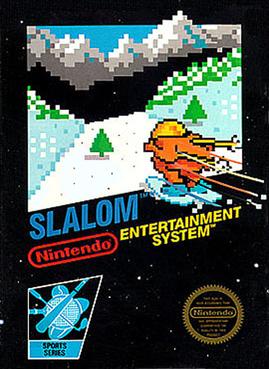
Slalom, originally released as VS. Slalom, is a skiing sports video game developed by Rare and published by Nintendo in 1986 for the Nintendo VS. System in arcades. It was then released for the Nintendo Entertainment System in North America in March 1987 and in Europe later that year. The player races in a series of downhill slalom skiing runs while navigating past flags and obstacles before time expires. It was developed by Tim and Chris Stamper and its music was composed by David Wise.
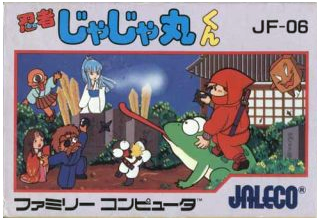
Ninja JaJaMaru-kun is an action-platform video game developed and published by Jaleco for the Famicom. It was released in Japan on November 15, 1985, and was ported to the MSX in 1986. The MSX version was released in Europe as Ninja II, being marketed as a sequel to Ninja-kun: Majou no Bouken, a game that used the name Ninja for its European MSX release.

Kirby is an action-platform video game series developed by HAL Laboratory and published by Nintendo. The series centers around the adventures of a pink round hero named Kirby as he fights to protect and save his home on the distant Planet Popstar from a variety of threats. The majority of the games in the series are side-scrolling platformers with puzzle-solving and beat 'em up elements. Kirby has the ability to inhale enemies and objects into his mouth, spitting them out as a projectile or eating them. If he inhales certain enemies, he can gain the powers or properties of that enemy manifesting as a new weapon or power-up called a Copy Ability. The series is intended to be easy to pick up and play even for people unfamiliar with action games, while at the same time offering additional challenge and depth for more experienced players to come back to.

Metroid is an action-adventure game developed and published by Nintendo. The first installment in the Metroid series, it was originally released in Japan for the Family Computer Disk System in August 1986. North America received a release in August 1987 on the Nintendo Entertainment System in the Game Pak ROM cartridge format, with the European release following in January 1988. Set on the planet Zebes, the story follows Samus Aran as she attempts to retrieve the parasitic Metroid organisms that were stolen by Space Pirates, who plan to replicate the Metroids by exposing them to beta rays and then use them as biological weapons to destroy Samus and all who oppose them.

Castlevania, known in Japan as Akumajō Dracula, is a 1986 platform game developed and published by Konami for the Family Computer Disk System. It was originally released in Japan in September 1986, before being ported to cartridge format and released in North America for the Nintendo Entertainment System (NES) in May 1987 and in Europe in 1988. It was also re-issued for the Family Computer in cartridge format in 1993. It is the first game in Konami's Castlevania video game series.

Kirby Battle Royale is a brawler multiplayer video game in the Kirby series. Developed by HAL Laboratory and published by Nintendo, the game was released on the Nintendo 3DS handheld game console in Europe and Japan in November 2017, and in North America in January 2018.

Power Spikes II is a volleyball arcade video game developed by Video System and originally published by Taito on October 19, 1994. A follow-up to Hyper V-Ball on Super Nintendo Entertainment System, it was first launched for Neo Geo MVS (arcade) and later ported to Neo Geo CD. It is the final installment in the Super Volleyball series. It is also the only volleyball game released on the Neo Geo.



















